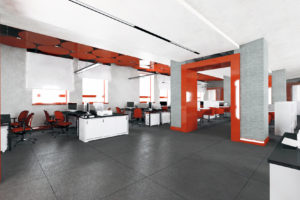The Pros
Improved engagement at work
The happiness of the American workforce has been declining for the past decade. Feeling fulfilled, also known as active engagement, can be a difficult achievement for many modern employees. According to Gallup’s 2016 State of the American Workplace report, just 33% of Americans actively enjoy working in their workplace. Over 50% of American workers are completely unengaged. They feel neither passion nor disdain for their job. Rather, these unengaged employees merely exist within the confines of their office. These unengaged Americans do not feel connected to their employer’s business and they only view their work as a means to a paycheck. Open concept offices can provide a solution to the severe lack of employee engagement.
Open concept offices increase employee engagement by providing employees with different environments to work in. According to the aforementioned Gallup report, employees in the workplace benefit from having a designated space – be it a desk, a locker, or even a chair – that they “own.” Providing employees with designated personal workspaces will make them 1.4 times more likely to be engaged with their work. However, employees also enjoy freedom of movement. When employees are provided with different areas to work in – and when employees are encouraged to move between these spaces – they are 1.3 times more likely to be engaged in their work compared to stationary employees. Open concept offices promote frequent movement due to the core basics of their design. In order to maximize engagement and productivity, open concept offices should assign each employee with their own workstation. While also providing the entire office with a handful of un-assigned, semi-private work rooms. Ultimately, the freedom of movement in an open concept office makes for more fulfilled employees.

An affordable office model
The open concept office saves many businesses money. Cellular offices require the construction of multiple walls, as well as the installation of permanent structures such as cubicles. Open concept offices embrace having few walls and barriers. With fewer walls than cellular offices, open concept offices centralize the control of heat, air conditioning, and lighting fixtures. A recent study found that up to 45% of energy consumption in buildings is due to lighting. With more natural light, open concept offices do not need to rely on artificial light sources as frequently as cellular offices. Heat and air conditioning are more affordable as well. In contained offices and cubicles, individuals control heat and air conditioning, but in open concept areas, you have centralized systems. With fewer walls in the way, air circulation in open concept offices is more efficient. The open concept office design conserves energy and improves airflow in an office. Businesses that opt for an open concept office will likely have a more affordable energy bill.
Prevents a sedentary lifestyle
A 2017 study on active design found that office employees who were moved from a traditional office space to an open concept office space spent 66% less of their time sitting while working (compared to spending 72% of their time sitting while working in a cellular office space). Additionally, these employees stood almost 20% more in an open concept office as opposed to when they worked in a cellular office. Sedentary lifestyles are a detriment to the US workforce. In a 2012 study, it was found that sitting for most of the day increases the likelihood of developing a risk of a terminal cardiac arrest by 90%. Additionally, the risk for a stroke or a heart attack increases by 147% for people with largely sedentary lifestyles. Therefore, open concept offices can help prevent the risks associated with sedentary lifestyles.
When compared to the stationary furniture in cubicles, the furniture in open concept offices is better for employee health. A 2016 OSHA report found that furniture with minimal ergonomic design – including cubicles – cost employers approximately $54 billion annually. This cost was due to many health issues. Primarily, this cost was due to workers’ compensation. Many of the injuries employees suffered due to poorly designed furniture included strained eyes and backs as well as the development of carpal tunnel. Open concept office furniture is designed to be robust: desks and chairs are designed to be wheeled around an office with ease. Therefore, the furniture is long-lasting. Many open concept offices also have multi-functional furniture; such as desks that have adjustable heights, allowing employees to sit or stand while working. Open concept offices are more likely to feature furniture that is better for employee health.
The Cons
Some illnesses get worse
While ergonomic furniture can be beneficial to employees, an open concept office can also prove damaging to employee health. One 2011 study found that employees working in open concept offices took 62% more sick days off compared to employees working in isolated cellular or cubicle offices. This study accounted for many factors including the socio-economic status of the study participants and their lifestyle decisions (such as smoking habits). Due to the communal nature of open concept offices, employees are more likely to come into contact with one another. And as a result pass around their illnesses.
However, there is one possible explanation for the higher rate of absenteeism: modern offices are embracing remote work. Many employees can choose to work from home despite being ill. They do not need to commute to their physical office. However they are still capable of completing all assigned work through company laptops and smartphones. While it is possible that employees are more likely to develop an illness in an open concept office. It is also easier for them to be absent from the office while still completing their work from home. Businesses that do not utilize remote work or that do not benefit from remote work will need to be prepared for more employees taking time off in open concept offices.
The severe lack of security
A major benefit to a cellular office design is the ability to lock away sensitive files and data. However, with open concept offices, often times the only storage locations available to employees are small lockers and unsecure filing cabinets. A 2017 study found that 75% of employees steal from their employer at least once. Employees stole an annual $50 billion from their employers. Thefts can come in the form of little items over time, such as staplers, pens, or folders. However, thefts can include more severe crimes, such as stealing company laptops or hard drives. In 2017, over half of all data breaches were due to criminal or malicious attacks which cost businesses $244 per capita. Theft is often a crime of opportunity. When information is easily accessible, it is easier for information to be stolen. With little privacy in open concept offices, employee information – such as personal passwords– is more accessible than in cellular offices. Open concept offices need to be vigilant with protecting both employee and business information.
The noise is distracting
While working in an open concept office can lead to happier employees, it can also lead to more distracted employees. Talking is the most distracting source of office noise for almost 50% of employees surveyed in a 2008 study. In this study, talking reduced the productivity of many employees. Conversations wasted an average of 21.5 minutes per day. A 2013 workplace satisfaction study found that nearly half of employees who worked in an open concept office found that noise significantly impacted their ability to work. Employees value sound privacy – that much is clear. With a lack of cubicle walls to dampen ambient noise, open concept office employees must struggle to balance collaborating with peers while also focusing on completing their work independently.
Some offices have tried to tackle this issue by introducing artificial sound into their open office, as an attempt to create a white noise effect. Many offices accomplish this by distributing sound systems in the office and playing pseudo-random noise. One group of psychologists theorized that introducing water-based sound masking systems would help nullify distractions from general office noise and talking, and that this system would be better than random noise. However, the results showed that the water-based sound systems were no better than the pseudo-random noise systems. Employers who choose to embrace an open concept office will need to decide how to address dampening noise without negatively impacting the core designs behind an open concept office.
Ultimately, open concept offices have both advantages and drawbacks. There are many factors for businesses to consider before moving forward with an open concept office design. So long as businesses understand the needs and nuances of their employees and of their industry, it is possible for an open concept office to be successful.

